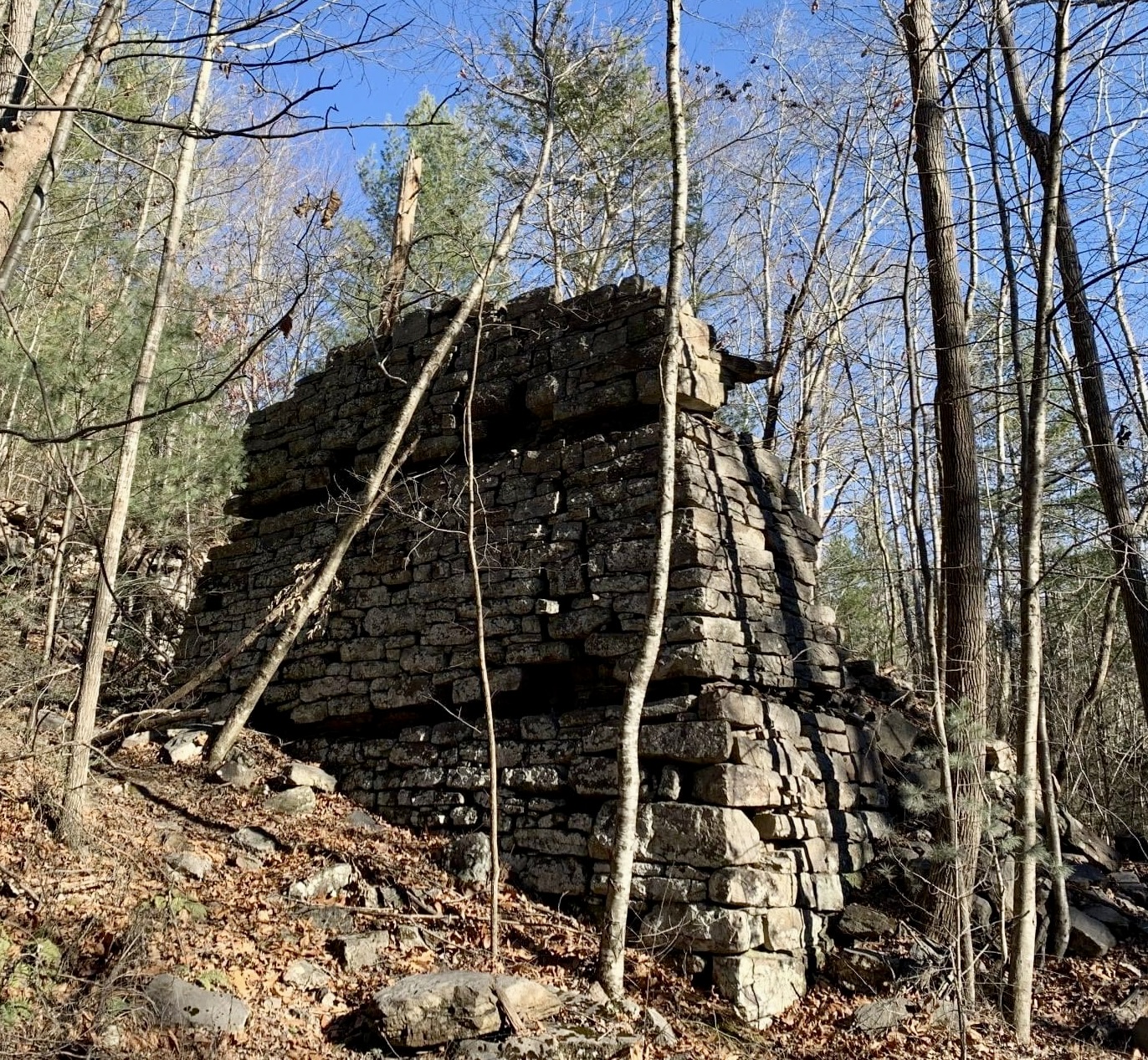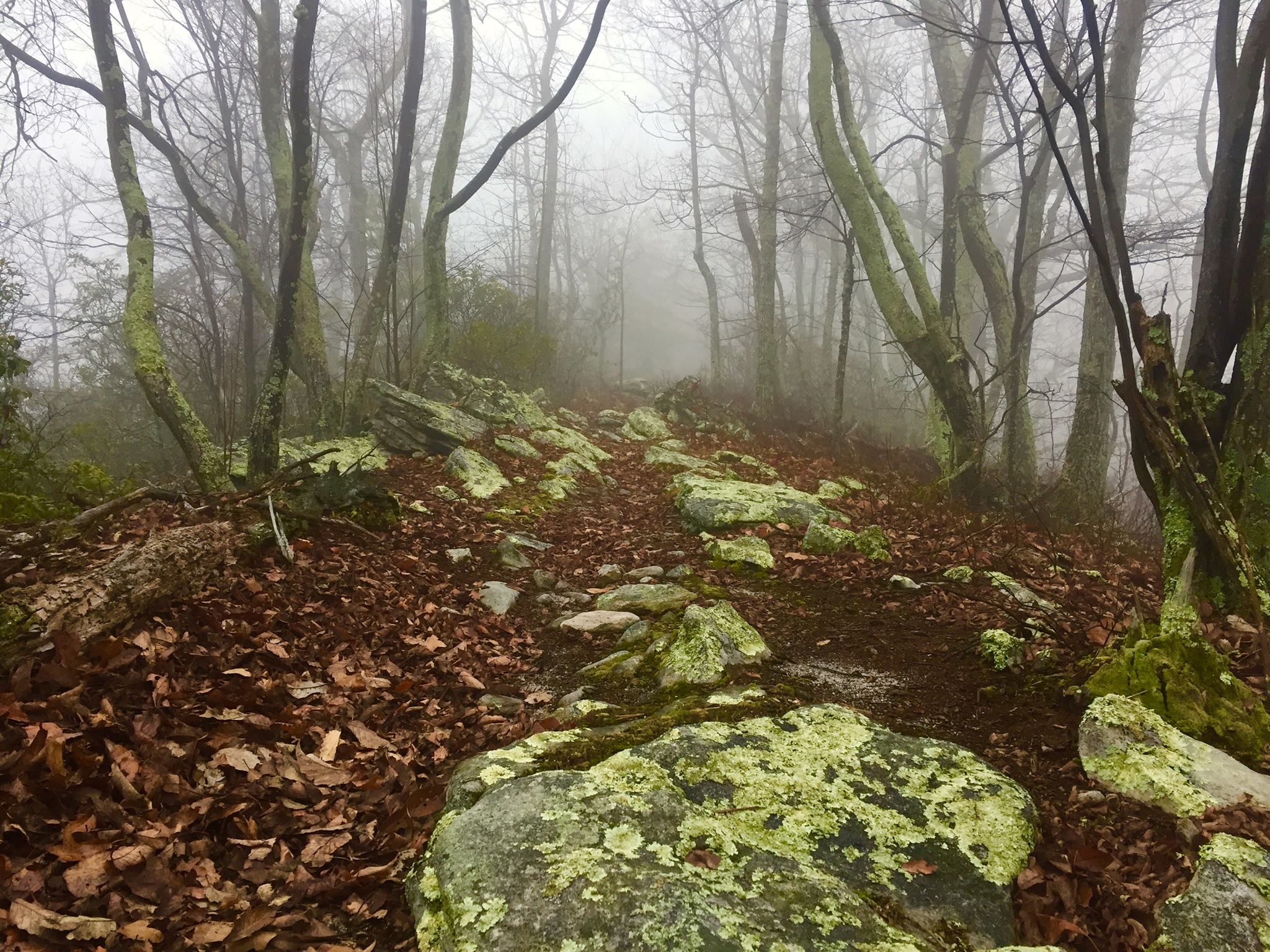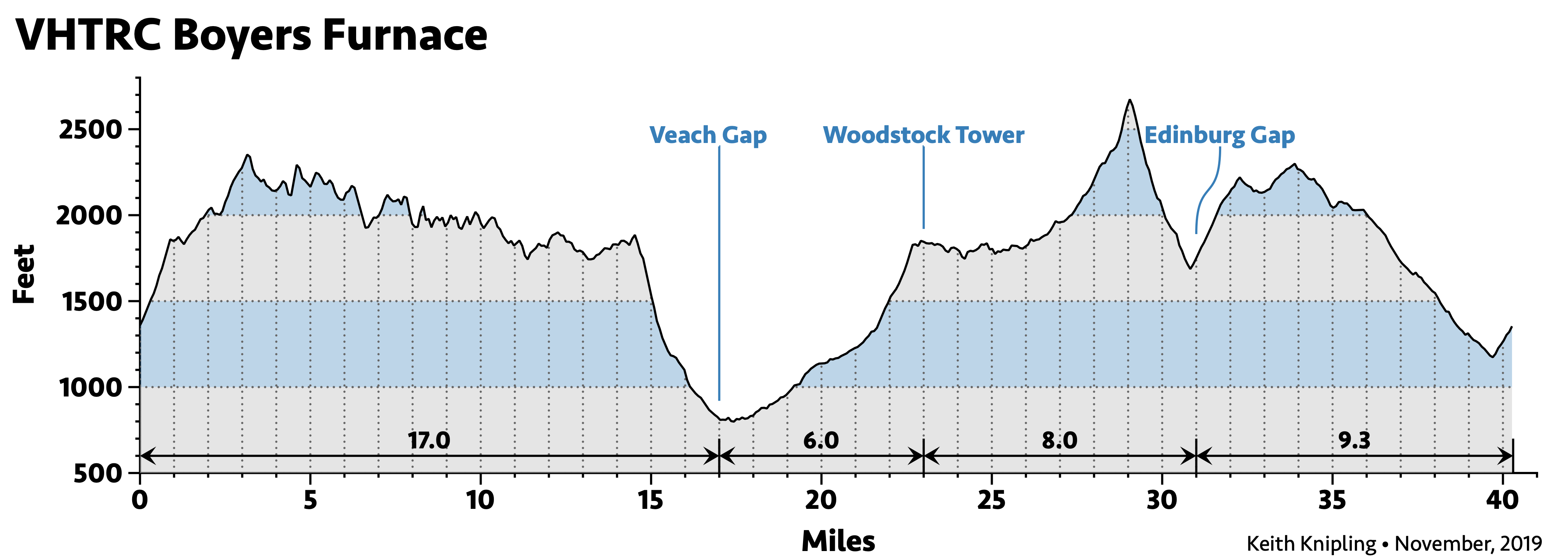View to the east and the Shenandoah Mountains, taken in the early miles of the 2014 run.
Keith Knipling
Boyers Furnace
A 40-mile loop through the Massanutten Mountains, named for Boyer’s Furnace, one of four iron blast furnaces operated in Fort Valley area during the 19th century. Runners pass the furnace ruins roughly halfway through the circuit.
- Date
-
- Sat Dec 27, 2025
- Start location
- Start time
-
- 7:30 am
- Distance
-
- 40.3 miles
- Total ascent/descent
-
- 6,500 feet
- Aid stations
-
- Veach Gap (17.0 miles)
- Woodstock Tower (23.0 miles)
- Edinburg Gap (31.0 miles)
- Entry
-
- Entry is open. Entry will be limited to 75 runners.
- Current entrants
- GPX file
- Print or download
- In charge
-
- Carol Cohen
- Reports
- Course records

Boyer’s Furnace is a minimally marked 40-mile loop through the Massanutten Mountains and around the southern half of the Fort Valley. The run was started in 2006 by Greg Loomis. It was under the able stewardship of Carter Cox (formerly Carter Wiecking) and then Tony Escobar for several years. Carol Cohen has directed the event since 2017, committed to providing the area trail running community with a quality “fat-ass” experience, on behalf of the VHTRC and in the tradition of Greg, Carter, and Tony.
The event is named for Boyer’s Furnace, one of four stone blast furnaces operated in the Fort Valley area during the 19th century. Runners pass the furnace ruins roughly halfway through the circuit, on a dirt road section while crossing the Fort Valley on the edge of the George Washington National Forest boundary line.
Course Details
Boyer’s Furnace is a formidable, counter-clockwise 40-mile loop that combines sections of both the Old Dominion and Massanutten Mountain Trails 100 mile runs. The course is a fair challenge, and it should take between 6 hours to 12+ hours to complete. The course can be broken into the following sections:
- 17 miles of at times technical Massanutten East ridgeline (stay on Orange to Veach Gap, then Yellow to the first aid station)
- 6 miles of primarily rolling dirt road (crossing the Fort Valley)
- 8 miles of tough Massanutten West ridgeline (again, stay on Orange)
- 9 miles of primarily rolling dirt road (with a closing stretch of paved road back to the Camp Roosevelt horse parking lot)
Aid Stations
There are three aid stations, at miles 17, 23, and 31. The aid stations will be stocked in part by items supplied by the runners.
Each runner will be asked to bring a single item for use by all at an aid station (such as a soda, Gatorade, or a food item).
The bulk of the common items at each of the aid stations will be supplied by the club, and you can expect some seasonally-appropriate treats at all three.
Each runner also has the opportunity to supply their own supplemental aid. Bring three labeled Ziploc bags with your personal food and/or drink options to the start, label them with your name, and drop them in the appropriate bins when you check in pre-race. Please use this option for food items only, and not for items such as clothing, shoes, poles, etc. The bins will make their way back to the start/finish after each aid station closes, in case you leave items in the bags that you hope to recover after you finish.
| Aid Station | Split | Cumulative | Crew access | Cutoff | Map |
|---|---|---|---|---|---|
| Veach Gap | 17.0 mi | 17.0 mi | ✓ | 1:00 pm | |
| Woodstock Tower | 6.0 mi | 23.0 mi | ✓ | 2:30 pm | |
| Edinburg Gap | 8.0 mi | 31.0 mi | ✓ | 5:30 pm | |
| Finish | 9.3 mi | 40.3 mi | ✓ | 8:00 pm |
It is essential that each runner carry enough food/water to make it through the first, potentially slow, 17-mile section. This will take all but the fastest runners 4+ hours to complete. In past years individuals with alternative distance plans have left cars at the various aid stations, enabling them to cut the run short. That is fine — just plan ahead and let the RD know that you plan to do so. It is very important that the race volunteers are aware if you drop out of the run early, so that the volunteers at later aid stations know that you are out of the event and not lost or hurt.
There are cut-offs. The first two are suggested only: 5:30 (1 PM) at Veach Gap (mile 17), and 7 hours (2:30 PM) up at Woodstock Tower (mile 23). The last two are hard cut-offs: 10 hours (5:30 PM) at the Edinburg Gap aid (mile 31), and then 12:30 (8 PM) at the Camp Roosevelt finish. It should be getting dark around 5:30 (the sun sets roughly at 5 PM at this time of year). Runners who finish in over 10 hours will need a flashlight for the closing stretch. The good news is that all of the course after the final aid station at Edinburg Gap is on country road sections, and not on technical single-track trail.

Course Markings
Markings are minimal, so the runner must be comfortable navigating a course using a map and turnsheet in order to participate. This is a MUST! Some of you will know this course, but those who are not 100% sure of the route should be carrying a turnsheet and a map. Carrying your cell phone is also a wise option, not only in case of emergency, but so that you can document the trail, your fellow runners, the bears, etc.
We also very much recommend that you download the GPX file from the column on the upper left. You can also access the public route posted on Strava here. Thanks in advance for preparing in advance to ensure that you can follow the Boyer’s course and keep from getting lost. This is particularly important since the event is held in the winter on remote mountain trails and roads
Entry
This event is a classic “fat-ass” run. There are no entry fees or awards. Weather permitting, there will be a bonfire at the end so don’t forget your camp chair. What better way to kick off your new training year, and knock off some holiday pounds, while also spending time on the trails with old friends and new? And if the weather is cooperative, you will be treated to some incredible views on both ridges of the Massanutten Mountains. The Very Best would be a nice, sunny day, with a nice layer of snow on the trails. So don’t be deterred if there has been recent snow in those mountains, be encouraged, instead!
Please confirm that this event really is for you prior to entering. The event will be limited to 75 runners in the starting field. Once the entry limit is reached and entry is closed, there will be NO wait list generated or maintained, and no late entries will be allowed. We actually prefer a smaller field on the day of the event than the maximum, due to parking considerations at Camp Roosevelt. So even though late drops will result in an entrants list smaller than the cap, we will not be accepting additional entries.
2024 Volunteers (not yet updated for the 2025 event)
Many thanks to the following group, all of whom have volunteered to come out to the mountains on this winter holiday to support their friends and fellow runners! We know all of the entrants will take the time to make each and every volunteer appreciated!
- Carol Cohen (your Boyer’s Furnace event director!)
- Q (Carol’s chauffeur)
- Andy Peterson (Course Marking/Firewood)
- Erin Altemos (Course Sweep - Veach to Finish)
- Jon Jester (Veach Aid Captain)
- Kevin Bligan (Veach Aid)
- Cara Mason (Veach Aid)
- Guy Towler (Veach Aid)
- Bill Pelton (Veach Aid)
- Moose Larson (Woodstock Aid Captain)
- Deb Cawthorn (Woodstock Aid)
- Ella Berkowitz (Woodstock Aid)
- Chef Jeff Best (Edinburg Aid Captain)
- Barry Hauptman (Edinburg Aid Captain)
- Ivory Lira (Edinburg Aid)
- Keavy Baylor (Edinburg Aid)
- Sarah Smith (Camp Roosevelt Finish Line Captain)
- Laura Berlin (Camp Roosevelt Finish Line)
Last updated November 17, 2025
Club Event Participant Medical Policy
This is an event with very real risks to your well being. The VHTRC does not provide medical care for runners at this event. Runners are responsible for their own health, safety, and well being at this event. No doctors, nurses, or emergency medical technicians, or anyone with any medical training are available along the course, at any aid station, or at the finish. The club does not supply any medical goods or services, including bandages, splints, antiseptic, or Ibuprofen or any other drugs to maintain the health of runners. Physical, medical, and emergency care is the runners' responsibility. In case of an emergency, we will endeavor to get local emergency personnel to an injured runner as soon as possible. Since most of our events are in remote areas, medical care may be far away in distance or time. Each year, runners finish — or are forced to drop out — with scrapes, deep cuts, hematomas, dislocations, and sprains. Runners have experienced cuts, bruises, bee stings, and asthma attacks. This is an event with very real risks.

